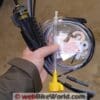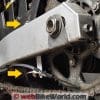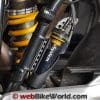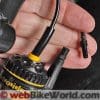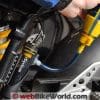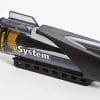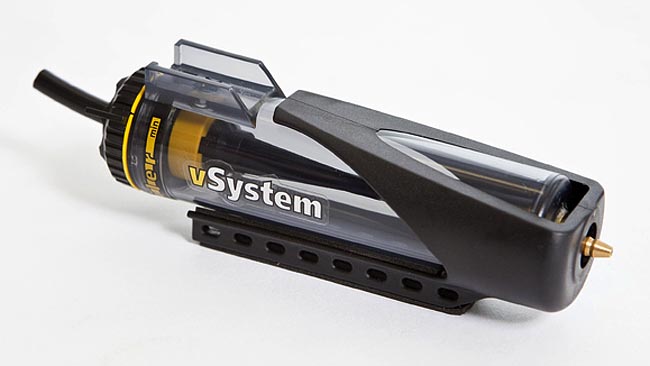The Scottoiler vSystem “California Spec” chain oiler is a CARB (California Air Resources Board) approved version of the popular Scottoiler vSystem chain lube kit.
The differences are minor, although the holder or receiver for the metering valve is new and this version has been approved for use with evaporative emissions systems.
Once you decide on a suitable location for mounting the dispenser tip, the rest of the installation is a piece of pie.
I often wonder why we’re still using chain drives on motorcycles, when the light weight, quiet, smooth and (nearly) maintenance-free belt drive has been a proven commodity.
I suppose there is such a huge body of knowledge and experience with the chain drive that manufacturers don’t want to change.
But I also suspect that it has something to do with the “not invented here” syndrome; Harley-Davidson, ironically enough, popularized the belt drive and perhaps other manufacturers don’t want to admit that H-D had a good idea?
In any case, we’re stuck with chains on many/most sportbikes, dual-sport bikes and more.
And that means we’re also stuck with chain adjustments and chain lube. Shaft drives excluded, of course — but they are not without their own specific maintenance issues!
Speaking of chain lubes, we’ve reviewed a veritable tanker ship full of the stuff over the last dozen years; just take a look at the right-hand column for the list and be sure to visit the webBikeWorld Motorcycle Oil page for more.
We also reviewed the original Scottoiler vSystem (review) (“v” for vacuum) and the rather exotic Scottoiler eSystem (review) (“e” for electronic) an electronically-controlled system, which is probably the ultimate chain lubrication delivery technology.
We have reviewed other automatic chain lube systems also, like the Cameleon chain oiler (review), which stores the oil in a long tube and delivers it via an electric control to the chain.
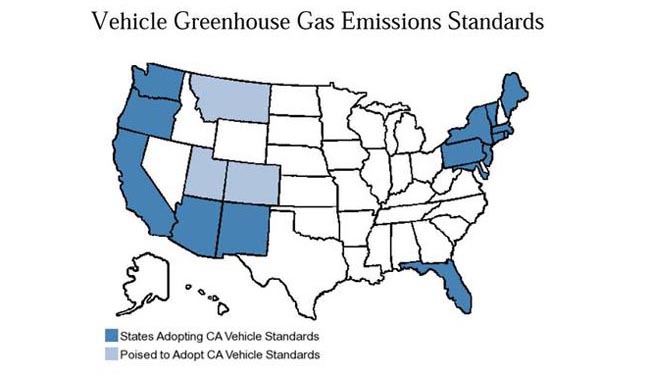
What’s a “California Spec”?
The original Scottoiler vSystem design is without a doubt the most popular automatic chain lube delivery system in the world, and with good reason.
First of all, it’s a simple design that is nicely executed and it been improved and evolved over many years. It also has a user base that surely extends into the tens — if not hundreds — of thousands.
So what’s the difference between the “original” Scottoiler (now called the Scottoiler vSystem non-California Spec) and the California Spec version? Not much actually…
The bottom line is that the California Spec version has an official certification to meet the California Air Resources Board (CARB) requirements so it can be legally used in CARB-compliant states.
I don’t live in California or in one of the states that uses CARB-similar rules, so I’m not familiar with the laws, but apparently any products that will be fitted to a motorcycle that could affect the emissions system must be tested by CARB for compliance.
Because the Scottoiler vSystem must is driven from the engine’s vacuum system, it must meet the requirements to be sold in California.
Scottoiler has a CARB Executive Order that effectively states that the Scottoiler vSystem does not adversely affect emissions.
The California Spec version (originally called the CARB EO version by Scottiler) of the Scottoiler vSystem has additional parts (extra tee pieces) that allow customers to fit the product to the motorcycle’s evaporative canister, as required in California and found on California spec bikes.
While they were at it, Scottoiler designed a new mounting cage/bracket/holder for the California Spec version to hold the Reservoir Metering Valve (aka RMV, the “bottle” that holds the chain lube oil and which meters it out to the dispenser tip).
The cage, or holder, for the RMV now has a slimmer profile that makes it easier to fit into tighter spaces.
For some reason, the new mounting holder or cage for the RMV is not in the non-California Spec kit, but I’m really glad it was included, because it makes it very easy to mount the RMV on the Ducati’s tube frame.
The kit also comes with a couple of rudimentary mounting brackets, appropriate lengths of hose or tubing and some cable ties.
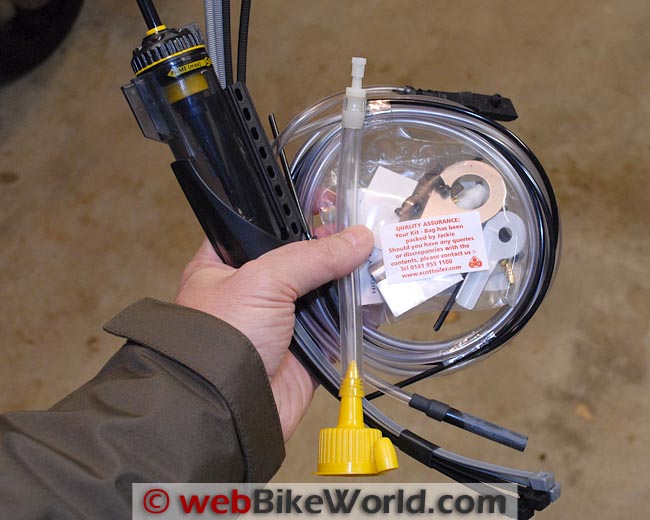
Installing the Scottoiler vSystem California Spec Chain Oiler Kit
The most difficult part about installing a Scottoiler is deciding on where and how to mount the dispenser tip.
It’s supposed to be positioned between 5 o’clock and 7 o’clock on the rear sprocket, with the tip slash pointing out and with the tip just clearing the top of the chain links.
But while this sounds easy, each bike is different, with different rear axle and swingarm types (dual and single), chain guides, chain guards and who knows what else.
This means that there unfortunately isn’t a single solution or instruction set for mounting the dispenser tip that will work on every motorcycle.
There is a fairly extensive support and technical information section on the Scottoiler website with mounting tips and advice and downloadable .pdf help guides.
The information focuses more on the installation of the RMV and the vacuum lines rather than the dispenser tip (although I can’t say I read every one of the bike-specific installation guides).
I’m a bit surprised that Scottoiler hasn’t developed a more useful database of swingarm mounting solutions, since mounting the dispenser tip is both the most difficult and most important part of the installation.
My suggestion would be for Scottoiler to use their customer base to help develop a database of all of the unique methods and installations that owners have invented to mount the dispenser tip and associated tubing for all of the different motorcycles on which a Scottoiler is installed.
In fact, I’d go even further and say that they should give away something like a year’s supply of oil or pay cash or something to every owner who submits photos and a description of how they mounted their Scottoiler.
I bet they’d have a nice database built up in no time.
Granted, the Ducati Multistrada 620 is a relatively rare bike, with a production run of only 2 years. But surely I can’t be the only 620 owner who has installed a Scottoiler?
In any case, once a suitable mounting location for both the RMV and the dispenser tip is determined, the rest of the vSystem installation is easy, because there are no wires to splice or electronics to connect or ground.
I didn’t even have to drill any holes on the Multistrada, because I could strap the RMV cage/holder to one of the down-tubes on the bike.
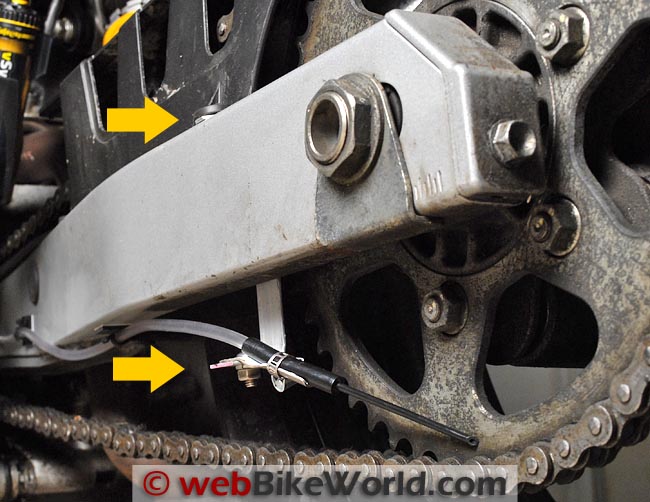
Mounting the Dispenser Tip
While at first it seemed simple enough to mount the dispenser at the required position, Chris and I noodled over this for quite some time before we struck upon a solution, quite by accident.
My plan (and my personal requirement) was to try and hide the mounting clamps and tubing from sight if possible, although if you’re not as obsessed with hiding the Scottoiler from view, then you’ll probably have many more options for mounting the dispenser.
And again, some motorcycles will have ready-made mounting points, like the Suzuki DR650 (blog), which has a chain guide hanging underneath the swingarm.
Pull out one of the bolts, pop in the mounting bracket and you should be good to go (although we didn’t mount the Scottoiler on this bike).
Also, I wanted to mount the system in a way that would allow the use of the Steel Horse swingarm stand (review), with its wide, flat saddles.
By the way, some owners have installed the Scottoiler in a truly “stealthy” location, with the dispenser tip on the front sprocket.
This can be done on some motorcycles with careful consideration and planning and a bit of extra effort (there is some information about this type of installation on the Scottoiler website).
Drill and Tap?
We first considered drilling the Multistrada swingarm to use a self-tapping, stainless steel screw to hold the dispenser tip bracket. Even though drilling into the swingarm isn’t much of an issue, I’d guess that most owners will not want to do it.
But the swingarm on this Multistrada has already been defiled with a couple of drilled holes that were made to mount the Multistrada hugger (report). The bike has the less expensive dual swingarm, made from square tubing.
It’s probably about 3-4 mm thick and it’s fairly easy to drill if needed.
If you’re going to drill into a swingarm, first use a center punch to ding the metal, then use a small drill bit for a pilot hole, then the correct size drill for the self-tapping stainless steel screw you’re planning on using to mount the bracket.
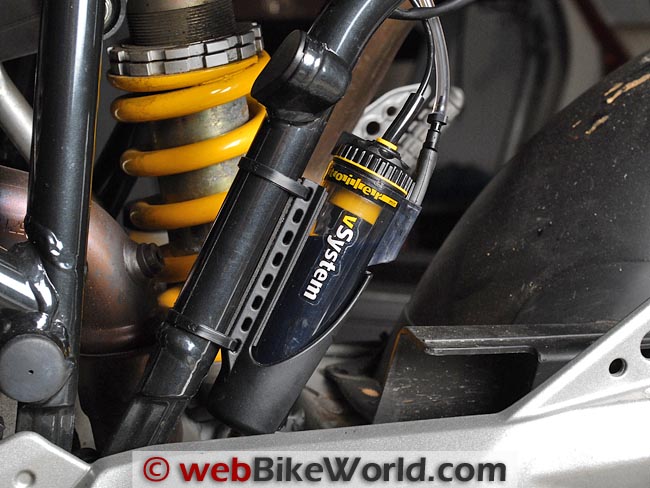
Don’t Forget the Swingarm Stand…
I could have simply drilled into the bottom of the swingarm and mounted the bracket pointing down towards the sprocket.
But we realized this would mean that the left-side saddle on the Steel Horse swingarm stand (review) would interfere with the Scottoiler dispenser tip and tubing and we wouldn’t be able to use the stand, which comes in very handy on this bike.
After trying a variety of different solutions, we decided to fashion a length of aluminum bar stock into a hanger, which would extend down past the bottom of the swingarm and hold the dispenser tip.
A large enough gap would still allow the saddle of the paddock stand to slide under the swingarm and fit without fouling the dispenser tip.
The Multistrada 620 has a screw that holds the chain guard just ahead of the rear sprocket, so I used a vice to bend the aluminum strip into a “C” shape, then made a trial fit on the swingarm box section, measured for the holes and drilled both ends of the “C”.
I then fit the home-made bracket in back of the swingarm to hide it from view. It could also be fitted across the front of the swingarm if desired.
It hangs down far enough to remain out of the way of the swingarm stand saddle — a nice solution, if you ask me, illustrated in the photo above.
I added a dab of silicone adhesive to hold the bracket tight against the back of the swingarm, just in case.
The aluminum is malleable and thin enough that it should bend or break off in the off chance that it gets fouled in the chain.
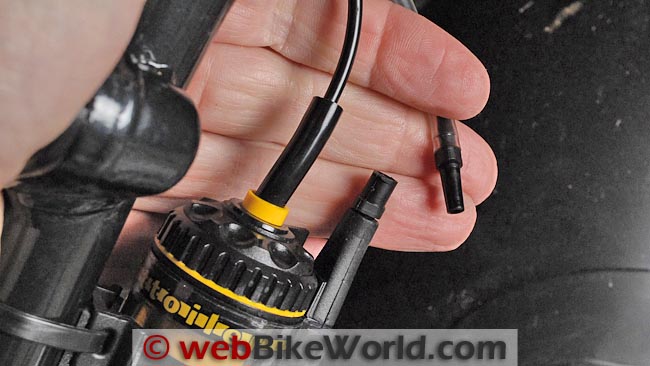
Installing the RMV and Tubing
Once the dispenser is mounted, the rest of the installation was a breeze and literally took a matter of a couple of minutes.
By the way, the instructions that come with the vSystem California Spec unit are fairly straightforward and they step you though this entire process, even if the printed layout is a bit odd.
It’s a fold-out sheet that is nicely illustrated.
I also suggest that you first study the annotated parts list to become familiar with the Scottoiler terminology.
This includes acronyms such as “RMV” for the Remote Metering Valve, which is basically the canister that holds the oil and which meters the oil to the clear hose and thence to the “dispenser tip”.
You’ll have to find a place to mount the RMV, of course, and it should be in a spot that is accessible, because you’ll need to access it to refill it with lube oil.
I mounted it vertically on a down-tube directly above the swingarm pivot point, as shown in the photo above.
The clear hose that feeds the oil to the dispenser tip has to run along the swingarm, from the RMV back to the dispenser tip, and Scottoiler throws in a few stick-on hangers for this purpose.
I cleaned the grease off the swingarm with degreaser and then rubbing alcohol and used two of the hangers, making sure there was enough slack for the suspension travel.
Also, it’s important to check everything to make sure there’s enough clearance and nothing will get hung up on the chain or moving parts when you’re riding.
A thin flexible tube must be routed up to the front of the bike, where a “T” fitting is spliced into a vacuum line or the emissions canister.
I cut the bike’s vacuum line and used the T fitting but the installation instructions also have tips on attaching the vacuum line to the evap canister or a vacuum take-off if your bike has one.
There’s one more hose — the breather, which can be routed anywhere up in the frame. The breather is necessary to equalize the pressure.
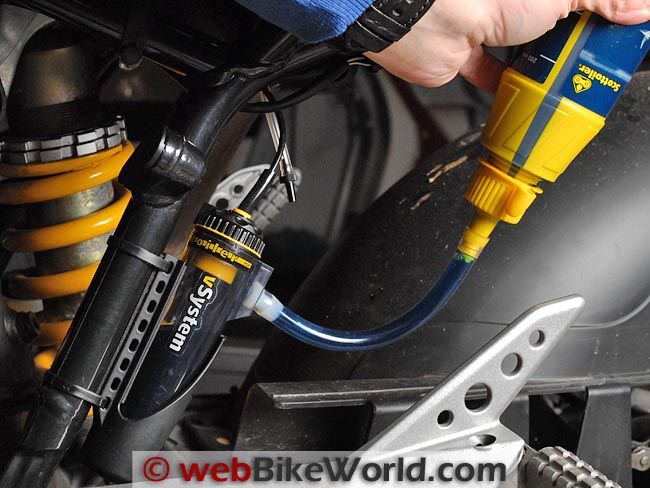
Priming and Timing
Once everything is installed, it’s time to fill the RMV with the lube oil. Scottoiler makes two different types of lube oil, both apparently designed for UK weather.
The blue oil that comes with the kit is recommended for temperatures ranging from 32 to 68 F (0 to 20 C). Scottoiler “red” oil is recommended for temperatures ranging from 68 to 104 F (20 to 40 C).
This can mean that you may have to switch from one oil to another at the end of Spring and then back at the end of Summer in most of the U.S., although I suppose the oils can be mixed without consequence.
The plastic oil bottle that comes with the kit has a hose that fits into the top of the RMV.
Turn the rotating metering dial on the top of the RMV all the way clockwise to the position marked “Prime”, connect the filling tube to the RMV, hold the bottle upside-down and give a few squeezes of the bottle and the RMV will fill up.
Accessories are available to increase the size of the reservoir if desired.
The bottle of oil then acts as a hand pump to prime the system by holding it upright and giving a squeeze, which forces the oil down through the hose along the swingarm and thence to the dispenser tip.
Again, it’s all in the instructions.
I had no problems getting everything to work quickly and easily the first time. I squeezed the bottle, priming the system until the first drop of oil came out of the tip.
I then took a guess and turned the metering dial on top of the RMV to half-way and started the bike and my stopwatch. After about 3 minutes, a single drop appeared; Scottoiler recommends about one drop every minute.
So I turned the dial another 1/4 turn towards “Prime” and timed it and sure enough, a drop appears about once every minute. It’s not really a drop or drip; it’s more like a seep.
On the Road with the vSystem
After the installation, the priming and the initial timing, I checked everything to make sure it was tight, then took the bike out for a ride. I stopped after about 5 miles for a check, then again around 20 miles and everything looked fine.
Since then, it has worked like a champ; silently and unobtrusively.
A close inspection of the chain reveals a very slight wetness around the links, which is perfect. Scottoiler says the oil will distribute across the chain by capillary action and this seems to be the case.
They do have a double-tipped dispenser unit as an option, but I’m not sure why it would be needed.
Note that the Scottoiler non-eSystem chain oilers are powered by engine vacuum. So the engine must be running for the oil to flow.
This means that it is possible for oil to drip off the chain and on to the floor or ground if the bike is sitting for more than a minute or so with the engine running.
Conclusion
The Scottoiler vSystem is the most popular automatic chain oiler/chain lube system in the world. Once a suitable location is determined for the dispenser tip for your specific motorcycle, the rest of the installation is easy.
Owners report many years and many miles of service without problems, and you’ll ride secure, knowing your chain is getting lubricated.
For lazy owners like me, who never seem to get around to cleaning and lubing a chain by hand, the Scottoiler has proven to be a real benefit.
And I feel less guilty about this important maintenance task, because I now know the system is on duty whenever I ride, silently doing the job for me.
Owners also report reduced wear on their motorcycle chain and sprockets, and considering the reasonable price of a Scottoiler system — and the cost of a chain/sprocket service — the Scottoiler should pay for itself in no time.
Also, Scottoiler has now set up a fulfillment in Atlanta, Georgia to satisfy the growing demand from the U.S. dealer and wholesaler network.
Nick Muddle of Scottoiler stated “This is great news for dealers and customers as we have made our products much more accessible. Now we can ship to most parts of America within 5-days.”
| wBW Review: Scottoiler vSystem California Spec Chain Oiler | |
|---|---|
| Manufacturer: Scottoiler | List Price: (2011) $129.95 (California Spec version). $97.46 (non-California Spec version). |
| Colors: N/A | Made In: UK |
| Review Date: December 2011 | |
Owner Comments and Feedback
See details on submitting comments.
From “J.S.” (April 2014): “The newly mounted vacuum Scottoiler on my Kawasaki Versys 650, with the red, high-temperature oil in it, worked as advertised on my first rides of the year in minus 6 Celsius temperatures.
A week later, I rode out in plus 8 degree weather and, after about 100 km, I found the reservoir half empty and flung oil all over the chain-side chicken strip of my rear tire. Which can be lethal.
Lesson learned: When there is any significant change in temperature, I reset the drip rate to accommodate the change in oil viscosity, due to the temperature change. So far, so good, I like it.”
From “M.H.” (February 2013): “The Scottoiler instructions and website specifically state not to fit the oiler the the front sprocket as most of the oil will fling off the chain.
I disagree, I fitted one to my CB900 Hornet as soon as I bought it, fed to the front sprocket. It’s much tidier than a rear sprocket installation, and much quicker. That first chain did 28K miles.
And as I lived in England, a high % was in rubbish weather, which is when the oiler is really needed. Yes, some oil ended up in the front sprocket cover, but not as much as you’d think and the stuff cleans up fairly easily.
I’ve also fitted and used Scottoilers using the rear sprocket and I can see no advantage to the extra hassle of a rear sprocket fitment.”
From “L.P.” (January 2012): “I noted there are several comments to the effect that the oiler only drips when the bike moves.
Unless there’s been a new development in the current design it drips at about the same rate all the time the engine is running; at least that’s how mine’s always worked.
This has always resulted in a few final drips on the garage floor, not a huge deal but it happens.
It’s been awhile since I last visited their web site but I seem to recall reading that you could use pretty much whatever oil was handy; the two grades they sell were more a matter of additional revenue for them.
When I bought my first system I ordered two bottles of the blue stuff, one of which has finally been used and the 2nd is barely started so they last a long time.
Overall I think the ScottOiler is pretty cool which is why I’m about to install one on another bike, this time the touring version with the larger reservoir; it’s an ideal accessory for bikes without center stands.”
From “D.S.” (December 2011): “I appreciate the advice and reviews that I get from wBW, and I’d like to contribute in a small way.
I just read the review of the CA-spec Scottoiler, and I was a bit taken aback by the trouble you went to in installing a clamp to correctly align the delivery tip.
I had a Scottoiler installed on my new ’08 SV650 naked back when it was new, and faced the same problem.
This was readily solved by the mechanic who did the job by attaching the tube to the underside of my swingarm using one of the supplied clips and a couple double-length zapstraps, and slipping a piece of malleable wire about 6” long inside the delivery tube.
The wire is easily shaped to the correct curve, and once set, stays that way. The wire diameter is smaller than that of the tube, and since flow rates are quite low, flow is not impeded.
Here is a link to my photo on Flikr which shows the set-up. The wire lies in pretty much the entire “fat” black tube length.
By the way, I’ve found it best to use a quite short (dispenser) “tip”, and I’ve also found that the tip wears out fairly quickly against the surface of the spinning sprocket (especially in wet, dirty weather).
It needs replacement now and again (maybe once a year, or – for me – every 25,000 kms). I hope this is of help. And keep up the good work!”
Rick’s Reply: As I mentioned in the “Mounting the Dispenser Tip” section above, one of my “must haves” was to keep the installation as “stealthy” as possible. I realize I could have easily tie-wrapped the oil feeder line to the swingarm, but that is not what I wanted.
Also, I needed to use the Steel Horse swingarm stand on the bike, which required an offset for the mounting clamp.
Once I figured it out, bending the aluminum and installing it took a matter of minutes, so I hope the article will encourage others to use the same or similar idea.
From “J.C.” (December 2011): “Forget about the weight advantages, forget about the lower parasitic losses, forget about the lower costs to design and manufacture….one major reason chain drive is still around and will never fully be supplanted by belt or shaft is the ease of changing final drive ratios.
Larger or smaller sprockets are cheap, simple to install (for the most part) and let riders easily tailor final drive ratios to suit their (often changing) needs, rather than the needs of the manufacturer (who tend to make serious gearing compromises to meet mileage or noise regulations).
Personally, I run a different front and rear sprocket on my Sprint ST when I’m using it for touring (taller, more economical gearing to stretch the range out here in the big, sparse West).
For weekend canyon bombing and commuting, I go back to stop-and-start friendlier and just “more fun” shorter gearing. Cost me about $200 for the “extra” set of sprockets and matching chain, and the flexibility almost gives me two different bikes.
On my Tuono, I also changed out the factory sprockets and chain, though that was a one-time affair, just wanted to get rid of the too-tall-but-EPA-compliant gearing it came with.
Try that on a HD or Buell. It can be done, but not easily or cheaply.
And on a shaft-drive? You’ll need to spend a lot of money and totally void warranty (what shaft owner really wants to do THAT, especially if it’s a BMW?) to change the final drive ratios.”
Rick’s Reply: Just for the record, this review is about a Scottoiler, not chain vs. belt drive! But, as long as we’re on the subject…
Actually, it’s the old “Which came first, the chicken or the egg?” situation.
Changing out a pair of belt sprockets would be no more difficult than changing chain sprockets and they should be no more expensive.
But there’s a catch: If more belt drives were used, there would be more sprockets available, but there won’t be more belt drive sprockets available until more belt drives are being used!
Also, let me take a not-so-wild guess and say that there are probably very few street/touring bike owners who actually swap out sprockets to change gear ratios on their bikes. It’s not the easiest project and it’s pretty expensive. I’ve done it myself (and here’s how).
From “J.A.” (December 2011): “You’ll find the answer to why lots of bikes still use chains in the naked truth of racing. It’s not hard to imagine why a chain would be preferred on an MX bike. Or a MotoGP bike.
It’s also not hard to understand why shaft drive might be a good idea on some big BMWs.
There’s a place for belt drive somewhere in between, but clearly it’s not appropriate for all applications.
Therein lies the answer to why we don’t see belt drive everywhere. It’s not because Harley invented it or was first to apply it to mainstream bikes.
A trip through the Art of the Motorcycle (or any other walk down motorcycling history’s memory lane) will remind you that belt drive is as old as the waterwheel.
By the way, wouldn’t a chain oiler like the one shown only oil one side of the chain?
I know that modern chains are sealed, and the oil will migrate, but if you’re a perfectionist, which a chain-oiler person person must be (in a good way!), it seems this would bug you. Since modern X- and O-ring chains keep their grease sealed inside the rollers, chain oilers are really unnecessary.
In fact, they will coat your chain with sticky goo that will attract dirt and grime.
I personally advise people to use a clean, dry chain lube applied infrequently. If you apply it too much, you get build-up and gunk. Dirt stuck to lube will wear on your chain and sprocket faster than a clean, dry chain.”
Rick’s Reply: Just for the record, I didn’t mean to imply that a belt drive should be on every type of bike, and I should have made that clear. Just that it probably should be and could be used more often than it is.
Also, I should have mentioned (and I mention this in my response to M.C.’s comments below also) that using the oiler doesn’t absolve owners from normal chain maintenance and adjustments.
The oil only drips when the bike is moving, and the position of the dispenser is such that the oil flows down on to the chain on to the rollers and then capillary attraction moves it through the entire chain. I thought I mentioned that but I’ll make sure it’s clear.
Scottoiler claims that the oil is specially designed to both flow through the chain and also to help keep the chain clean and free from gunk, dirt, etc.
When correctly adjusted, the oil flow is so small (one tiny drop per minute) that the chain appears to be dry anyway; it’s just enough oil to keep things lubricated.
I agree that with modern O/X/W/Z ring type chains, not much lube is needed; in fact, we posted a webBikeWorld News article recently about the new RK GXW chain, which is guaranteed for 20,000 miles (as long as proper maintenance is performed).
Scottoilers have been sold for many years and I know there are many thousands (probably hundreds of thousands) of users, so it’s a proven technology that has been around for some time. Users are usually very happy with the results.
For lazy guys like me, who basically never lube a chain anyway, it’s also probably a good idea!
From “M.C.” (December 2011): “Belt vs Chain…screw both of them! Shaft drive is better. However, that’s not the subject at hand.
I have a problem with automatic chain oilers. Riders should be getting down on their hands and knees and checking the condition of their drive system when they lube their chain.
Adding another gadget to our bikes that takes the human factor out of a process makes us a slave to that technology and opens up for the potential of someone riding a bike that’s has a failure waiting to happen that could have been caught when they actually looked at their bike.
Point two….Unless you’re a total idiot and still using a non-O-ring chain, any lube you squirt on the chain is only lubing the outer rollers and not the bushings and pins.
As I look at the picture of this gizmo, it looks to me to be wasting 99% of the lube. Lubing the outside edge of the sprocket wont do much good.
Setting this oiler up to lube the critical roller area and keeping it adjusted seems to me like more of a pain … then just getting down and dirty like we always have. And while you down there…how’s that rear tire look?
Oh and the suspension linkage? What about those rear brake pads…..and so on.”
Rick’s Reply: I should have mentioned that using the oiler does not absolve owners from normal chain maintenance and adjustments.
The oil only drips when the engine is running and the position of the dispenser is such that the oil flows down on to the chain on to the rollers and then capillary attraction moves it through the entire chain.
From “F.M.” (December 2011): “The Buell motorcycles have used belts for years. In recent years, the belts have become lifetime service items that never need replacing or adjusting.
In fact, Buells have no adjustment possible for the belts — they are manufactured to that tight a tolerance.
Anecdotal, hearsay claims about belt failures aside, belt drives are proven, reliable technology.
I’ve watched professionally prepared race bikes have chain failures, so let’s not pretend that one man’s success with chains proves chains to be 100% reliable.”
From “B.B.” (December 2011): “Just a word on your comment re chains and “not invented here”. A mate of mine has owned an HD for over 10 years and in this time has had 2 broken belts, leaving him stranded and waiting for the breakdown van both times. In over 40 years of bike riding neither he or I have ever had a chain break. ‘Nuf said?… but now I ride a Guzzi anyway so I reckon I can’t be accused of bias!”
Rick’s Reply: Harley drive belt failures are rare and there are reports of some owners getting over 100,000 miles and/or 15+ years of riding on the same belt. For example, the recommended lifespan of a belt on a V-Rod, the most powerful Harley, is something like 43,000 miles.
Misalignment, foreign objects (e.g., rocks) and belts that aren’t adjusted correctly are the most likely cause of belt failure and your friend should definitely have someone look at his drivetrain.


